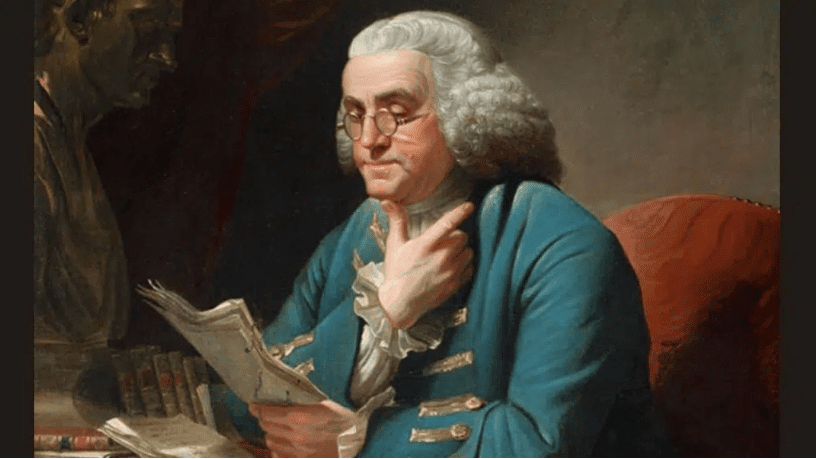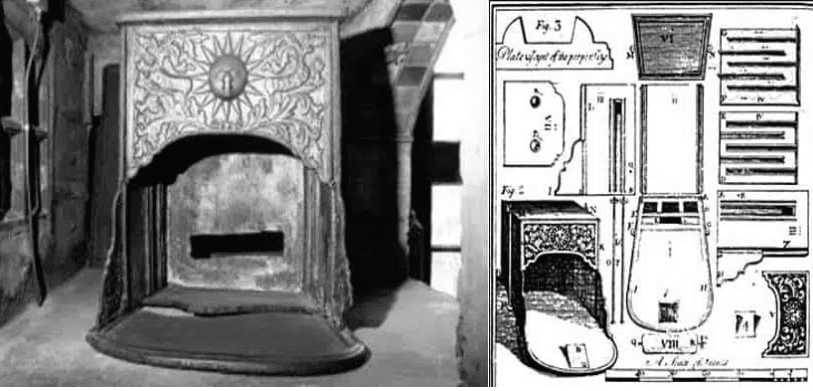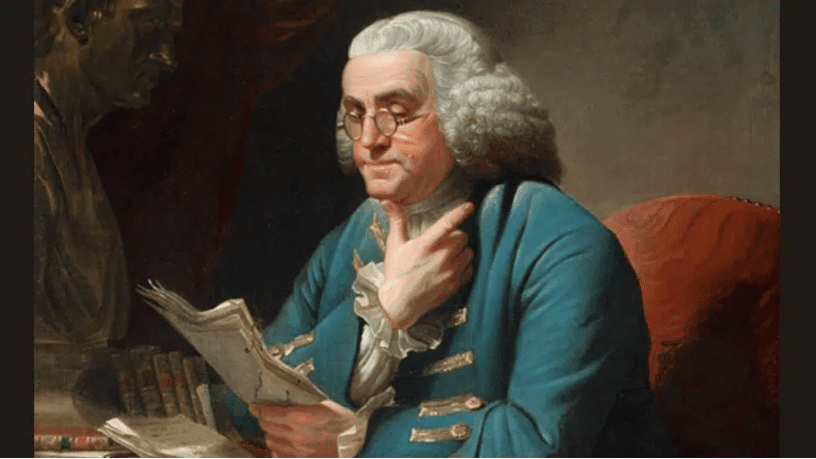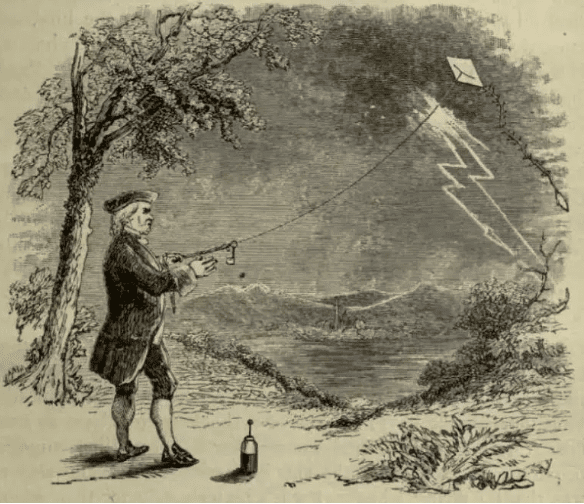Benjamin Franklin was born on January 17, 1706 in Boston, Massachusetts. He was the 15th child and youngest son in a family of 17 children. His parents, Josiah and Abiah Franklin, were hardworking people. His father made soap and candles in his shop on Milk Street.

Many historians consider Benjamin Franklin to be one of the most talented and successful diplomats in American history. But he was also a printer, scientist, and inventor in the United States until the time of Thomas Edison.
Franklin had many inventions. The most famous among them were lightning rods, that is, anti-lightning, glass harmonica, Franklin stove, bifocal glasses. Franklin was one of the first people in the world to experiment with electricity. In 1752, he conducted a research to prove that lightning was electric. He continued this research with the Leiden bottle.
- The statue he bought for $35 turned out to be a two-thousand-year-old bust of Ancient Rome!
- The Genetic Origins of the World’s First Farmers Are Becoming Clear
In 1752, during a stormy weather, he used a kite he made himself. According to Franklin’s notes, lightning struck the pointed wire attached to the kite, went to the key at the end of the kite rope, where it caused a spark. And Leiden managed to load his bottle.
Franklin made a significant improvement after this experiment. The results of this experiment led to the discovery of the lightning rod in the coming period.
Breakthrough Inventions

Benjamin Franklin has distinguished himself through inventions in different fields throughout history. One of them is the nomenclature of negative and plus electric charges. During lightning rod work, he calls the excess of electricity as plus charged and the deficiency as negative charged.
The Franklin stove can be considered the most useful invention for the people of its time. This assembly became famous for making heat even more efficient. With this method, Franklin made the living room twice as hot as he used it, with a quarter of the fuel he used.
People also appreciated his invention of bifocal glasses (dual vision glasses). This invention allowed both reading and remote lenses to be placed in a single frame. Thus, the near and far view was made available together.
Also, historians generally agree that Franklin invented electrical terms such as armature, capacitor, and battery. Franklin refused to patent or use any of his inventions for profit. Franklin, who wanted his inventions to contribute to everyone’s comfort, preferred that they be used freely.
Being a Pioneer in Politics
In politics, his opposition to the Stamp Act, one of the reasons for the American Revolution, led him to reach the highest point of his career. The people in the American Colonies were unemployed and penniless, wanting to build a new life for themselves beyond the mountains. But the British government had forbidden the establishment of new colonies.
In the colonies, trade was stagnant, coins were scarce. On top of this, the British created a tax called the “Stamp Act”. Franklin, along with the American colonies, vehemently opposed it.
Franklin appeared before the House of Commons to answer a series of questions about “non-representative taxation.” Councillors posed questions to him for about two hours. He replied briefly and clearly. His knowledge of tax issues impressed everyone, and his fame grew throughout Europe. Thus, the Stamp Act was repealed shortly thereafter.
The people of Philadelphia elected Franklin to serve in the Second Continental Congress. He later helped draft the Declaration of Independence and was one of the signatories of the document. Shortly after the Declaration was adopted in July 1776, Congress appointed Franklin as one of three commissioners to represent the United States in France.
Franklin was loved and embraced by the French people. Thus he eventually won French support during the American War of Independence. He helped draft the Treaty of Paris that ended the war, and was a signatory to it.
Benjamin Franklin

He was a man who knew everything and was a master of many subjects. Probably no American has done so much so well, except Thomas Jefferson. Throughout his long and useful life, Franklin was interested in such diverse subjects as statesmanship, soap making, book printing, cabbage cultivation, the rise of tides and the fall of empires. He also invented an efficient stove and proved that lightning is electric.
As a statesman, Franklin was at the forefront with the people who founded the United States. He was the only person to sign all four of the most important documents in American history: the Declaration of Independence, the Treaty of Alliance with France, the Treaty of Paris, and the Constitution of the United Kingdom.
Franklin’s services as a diplomat in France greatly helped win the War of Independence. Many historians still consider him the most talented and successful diplomat America has ever sent abroad.
Franklin was the leader of his time in electrical research. As an inventor, he was unique in the United States until the time of Thomas A. Edison. People still quote Franklin’s (Poor Richard) words from Poor Richard and read his autobiography.
Franklin helped build Pennsylvania’s first university and America’s first city hospital. Franklin’s fame began to spread successfully in Europe as well as America. Thomas Jefferson called Franklin “a man of his age and country.” The Comte de Mirabeau, a French statesman, referred to Franklin as the “wise man.”
Franklin’s Youth Studentship and Apprenticeship
Benjamin only attended school in Boston for two years. He proved to be excellent at reading, normal at writing, and weak at arithmetic. Josiah Franklin decided that he could no longer get an education for his youngest son.
Almost everyone in this crowded family had to work. He didn’t send Benjamin to school after he was 10 to help cut wicks and melt tallow in a candle and soap shop. Franklin’s formal education ended, but his education would never end. He read every book he could get his hands on.
She worked on her own writing style, using a volume of the British magazine The Spectator as a model. He also learned the basic principles of algebra and geometry, navigation, grammar, logic, natural and physical sciences.
He studied French, German, Italian, Spanish, and Latin, and partly mastered these languages as well. He eagerly read books such as Cotton Mather’s ‘Essays to Do Good’ and Daniel Defoe’s ‘Robinson Crusoe’.
Franklin made himself one of the most educated people of his time. When he was 12 years old, his father persuaded him to apprentice with his older brother James, a printer who was a printer. James is a good teacher and Benjamin proved to be a good student. He soon became a skilled printer. The brothers often argued, and Benjamin wanted to be his own boss.
At the age of 17, Franklin fled to Philadelphia, the largest city in the American colonies at the time. His arrival in Philadelphia has become a classic of American folklore. Many stories written about; it describes a fugitive apprentice who bravely walks down Market Street, carrying a Dutch dollar in his pocket, a loaf of bread under each arm and eating the third loaf.
Printer
From 1723, Franklin went to London to buy a printing press while working in a printing house in Philadelphia. Here he stayed and worked for printers in England. In 1728, at the age of 22, he became a partner in a printing press. Two years later, he became the sole owner of the business.
He began publishing The Pennsylvania Gazette and wrote most of its material himself. The name Franklin gradually became famous in all the colonies.
Franklin had a simple formula for his success. He believed that successful people should work a little harder than their competitors. As one of his neighbors put it: “Franklin’s industry is superior to anything I’ve ever seen. When I get home from the club, I see him still working and when I get out of bed he’s back at work.”
Later in 1730, Franklin married Deborah Read, the daughter of the first landlady in Philadelphia. Deborah was not as well-educated as her husband. But Franklin’s parents were a loyal couple. Franklin had three children, two boys and a girl. William, one of the children, became governor of New Jersey.
Electrical Tests
Benjamin Franklin was one of the first people in the world to experiment with electricity. He became famous for describing an electrical experiment he said he was conducting in Philadelphia. He described how he flew a homemade kite during a storm in 1752 to prove that lightning was electric.
According to Franklin, the lightning struck a pointed wire attached to the kite and went to the key at the end of the kite rope, where it caused a spark. Franklin also domesticated lightning by inventing the lightning rod. He urged people to use the device “as a way to protect settlements and buildings from disaster from thunder and lightning.”

When lightning struck Franklin’s house, the solidity of his invention was proven in this way. The lightning rod saved the building from damage. Franklin’s lightning rod proved the saying, “One gram of precaution is worth a kilo of treatment.” Franklin’s experiments with electricity also involved some personal risks. At least once he found himself unconscious on the ground. He had tried to kill a turkey with an electric shock. Here he was trying to understand the power of electricity, but something happened and Franklin, not a turkey, fell to the ground and could not get up for a while. Franklin later said of the incident:
“I wanted to kill a turkey with electricity, but instead I almost killed a goose.”
Other Works
Franklin was the first scientist to study the movement of the Gulf Stream in the Atlantic Ocean. Working with experienced ship captains, he discovered the Gulf Stream by measuring the temperature of the water, the bubbles that rise to the surface, changes in the color of the water, and made a map of it.
In order to take advantage of the daylight in the summer months, he always preferred the time interval from sunrise to sunset. It would seem foolish and wasteful to him that people “work by candlelight and sleep in sunlight.” Franklin also showed Americans how to improve acidic soil using lime.
Franklin appreciated the creative efforts of other people. He once said he wanted to go back to earth a hundred years later to see how much progress humanity had made.
The first successful balloon flight took place in 1783 during Franklin’s stay in Paris. Most of the audience mocked this new invention and asked ‘what good will it do for us?’ Franklin replied without hesitation, “What good is a newborn baby?”
Death of Benjamin Franklin
Benjamin Franklin’s accession to the Constitutional Convention was his last major public service. But his interest in public affairs continued until the end of his life. He was delighted and supported Washington’s inauguration as the first president of the United States.
In 1787, he was elected president of the first anti-slavery group in America. Franklin’s last public action was to sign a text calling on Congress to urgently abolish slavery.
Franklin died on the night of April 17, 1790, at the age of 84. About 20,000 people came to his funeral. Franklin accomplished a lot in many areas, but he began his will with the simplest words when describing himself: “I, Benjamin Franklin, the printer…”
Franklin left almost all his money in Boston and Philadelphia. Part of this was used to establish the Franklin Technical Institute, fund a trade school in Boston, and establish the Franklin Institute Science Museum in Philadelphia.
